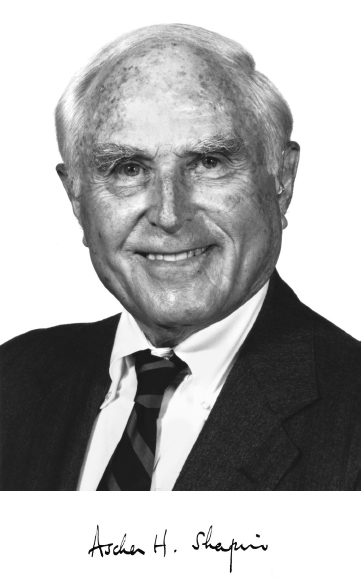1915–2004
Elected in 1974
“Contributions to fluid mechanics research and education.”
BY ROGER D. KAMM
SUBMITTED BY THE NAE HOME SECRETARY
ASCHER H. SHAPIRO, a leader in the field of compressible fluid flow, one of the early pioneers in biomedical fluid mechanics, and a dedicated educator, died on November 26, 2004, at the age of 88.
He was born in New York City on May 20, 1916, son of Lithuanian immigrants, and grew up there. When it came time to attend university, he initially chose City College of New York, but after several years migrated to the Massachusetts Institute of Technology (MIT), where he stayed for his entire career. He received his SB degree in 1938 and ScD in 1946, and then moved through the ranks: laboratory assistant in 1938, instructor in 1940, assistant professor in 1943, associate professor in 1947, and professor in 1952. He became chair of the MIT faculty in 1964, but stepped down in 1965 to become head of the Department of Mechanical Engineering, a position he held until 1974, when he attained the highest honor bestowed on MIT faculty, Institute Professor.
Ascher’s research focused on high-speed flight, turbo-machinery, and power production during the first 25 years of his career. During that period, he was a member of the Lexington Project to evaluate the concept of a nuclear-powered aircraft and director of the Atomic Energy Commission’s Project
Dynamo to study the prospects for using nuclear energy for electricity generation.
Ascher was a prolific and gifted author of textbooks. A major achievement was his publication of a two-volume text, The Dynamics and Thermodynamics of Compressible Fluid Flow (Wiley, 1953 and 1954), which is still in print today and has been translated into many languages. It served for many years as the “bible” of compressible fluid flow, and the care and precision with which it is written reflected Ascher’s deep dedication to education. In addition, his book Shape and Flow: The Fluid Dynamics of Drag (Anchor Books/Doubleday, 1961) presented a lucid description of boundary layers and drag on bodies of various shapes, written in a manner that made it widely accessible.
Another example of Ascher’s dedication to education was the series of films on fluid dynamics produced by the National Committee for Fluid Mechanics Films, which Ascher founded in 1961. These films became classics, and for many students were the means by which they obtained a fundamental grasp of underlying physical concepts of fluid flows. When completed, there were 39 videos in the collection, several of which Ascher scripted and appeared in, others featuring the leading figures of fluid mechanics of the time from around the world. According to Ronald Probstein, Ford Professor of Engineering Emeritus in MIT’s Department of Mechanical Engineering and fellow member of the MIT Fluid Mechanics Lab, “Producing those films was one of the joys of his life.”
In the early 1960s, Ascher’s research made a decisive turn from compressible flow to the nascent field of biomedical fluid mechanics. His pioneering works addressed such issues as peristaltic pumping in the intestine and design of an intraaortic balloon pump, a device developed by a Boston-based company and used for many years to provide temporary assist to patients in heart failure. In the early 1970s, Ascher published a series of seminal papers on flow in collapsible tubes, drawing on his background in compressible flows and the similarity in form of the governing equations. These led to important contributions to our understanding of blood flow
in the low-pressure venous circulation, and the use of external pneumatic compression to prevent deep vein thrombosis and of high-frequency ventilation to maintain gas exchange in prematurely born infants suffering from respiratory distress syndrome.
For his accomplishments in research and education, Ascher was recognized by numerous awards and honors. From the American Society of Mechanical Engineers, he received the Charles Russ Richards Memorial Award for outstanding achievement by a young researcher in 1960, and the Worcester Reed Warner Medal in 1965 for “outstanding contribution to the permanent literature of engineering.” In recognition of his educational contributions, he was awarded the Lamme Medal in 1977 from the American Society for Engineering Education. He was elected to the National Academy of Sciences in 1967 and the National Academy of Engineering in 1974. He had a long association with the Technion, the Israel Institute of Technology, where he received an honorary doctorate and served on the board of governors for 20 years.
In Ascher’s “other” life, he was a patron of the arts, especially the Boston Symphony Orchestra, which he attended regularly. When he could not attend himself, he generously passed his tickets on to his appreciative students, and I was pleased to be a beneficiary of his generosity. He was a gentle individual but did not shy away from speaking his mind in his interactions with either students or colleagues. His comments were always astute and reflective of his deep understanding of the fundamental concepts of fluid mechanics. He was held in the greatest respect by all who came to know him.
His daughter Mary Handel says:
The essay has enlightened me regarding my father’s academic activities. He was so devoted to his children and grandchildren and their activities that I was not thoroughly aware of how he spent his time at MIT. He was always available to be with us and never seemed pressed for time. His hobbies of gardening, squash, and the archeology of Israel also gave him great pleasure.







